Victoria Palhares
CSI2Vec: Towards a Universal CSI Feature Representation for Positioning and Channel Charting
Jun 05, 2025Abstract:Natural language processing techniques, such as Word2Vec, have demonstrated exceptional capabilities in capturing semantic and syntactic relationships of text through vector embeddings. Inspired by this technique, we propose CSI2Vec, a self-supervised framework for generating universal and robust channel state information (CSI) representations tailored to CSI-based positioning (POS) and channel charting (CC). CSI2Vec learns compact vector embeddings across various wireless scenarios, capturing spatial relationships between user equipment positions without relying on CSI reconstruction or ground-truth position information. We implement CSI2Vec as a neural network that is trained across various deployment setups (i.e., the spatial arrangement of radio equipment and scatterers) and radio setups (RSs) (i.e., the specific hardware used), ensuring robustness to aspects such as differences in the environment, the number of used antennas, or allocated set of subcarriers. CSI2Vec abstracts the RS by generating compact vector embeddings that capture essential spatial information, avoiding the need for full CSI transmission or reconstruction while also reducing complexity and improving processing efficiency of downstream tasks. Simulations with ray-tracing and real-world CSI datasets demonstrate CSI2Vec's effectiveness in maintaining excellent POS and CC performance while reducing computational demands and storage.
LoFi User Scheduling for Multiuser MIMO Wireless Systems
Jan 08, 2024



Abstract:We propose new low-fidelity (LoFi) user equipment (UE) scheduling algorithms for multiuser multiple-input multiple-output (MIMO) wireless communication systems. The proposed methods rely on an efficient guess-and-check procedure that, given an objective function, performs paired comparisons between random subsets of UEs that should be scheduled in certain time slots. The proposed LoFi scheduling methods are computationally efficient, highly parallelizable, and gradient-free, which enables the use of almost arbitrary, non-differentiable objective functions. System simulations in a millimeter-wave (mmWave) multiuser MIMO scenario demonstrate that the proposed LoFi schedulers outperform a range of state-of-the-art user scheduling algorithms in terms of bit error-rate and/or computational complexity.
High Dynamic Range mmWave Massive MU-MIMO with Householder Reflections
Oct 19, 2023



Abstract:All-digital massive multiuser (MU) multiple-input multiple-output (MIMO) at millimeter-wave (mmWave) frequencies is a promising technology for next-generation wireless systems. Low-resolution analog-to-digital converters (ADCs) can be utilized to reduce the power consumption of all-digital basestation (BS) designs. However, simultaneously transmitting user equipments (UEs) with vastly different BS-side receive powers either drown weak UEs in quantization noise or saturate the ADCs. To address this issue, we propose high dynamic range (HDR) MIMO, a new paradigm that enables simultaneous reception of strong and weak UEs with low-resolution ADCs. HDR MIMO combines an adaptive analog spatial transform with digital equalization: The spatial transform focuses strong UEs on a subset of ADCs in order to mitigate quantization and saturation artifacts; digital equalization is then used for data detection. We demonstrate the efficacy of HDR MIMO in a massive MU-MIMO mmWave scenario that uses Householder reflections as spatial transform.
Channel Charting in Real-World Coordinates
Aug 28, 2023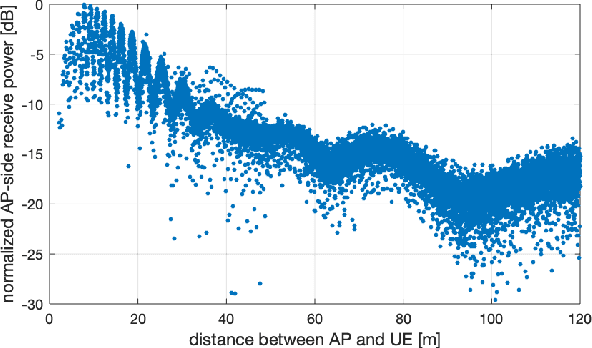
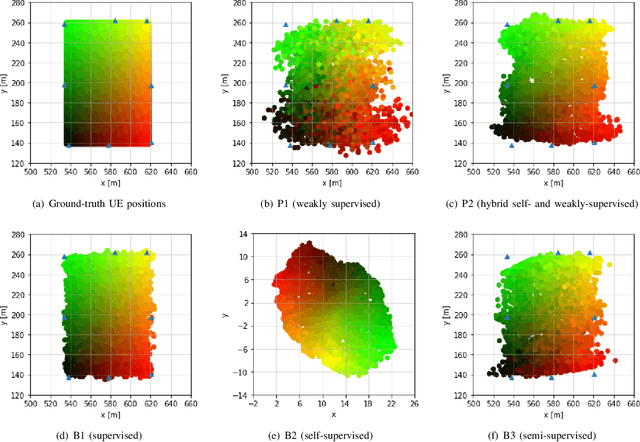
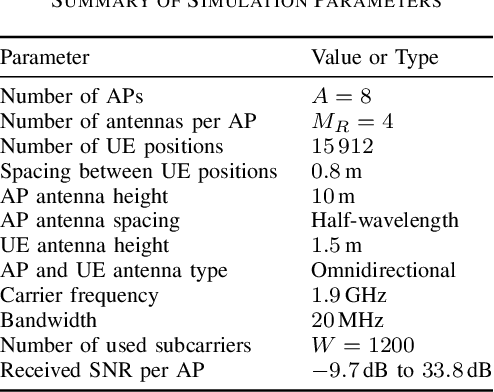

Abstract:Channel charting is an emerging self-supervised method that maps channel state information (CSI) to a low-dimensional latent space, which represents pseudo-positions of user equipments (UEs). While this latent space preserves local geometry, i.e., nearby UEs are nearby in latent space, the pseudo-positions are in arbitrary coordinates and global geometry is not preserved. In order to enable channel charting in real-world coordinates, we propose a novel bilateration loss for multipoint wireless systems in which only the access point (AP) locations are known--no geometrical models or ground-truth UE position information is required. The idea behind this bilateration loss is to compare the received power at pairs of APs in order to determine whether a UE should be placed closer to one AP or the other in latent space. We demonstrate the efficacy of our method using channel vectors from a commercial ray-tracer.
Beam Alignment for the Cell-Free mmWave Massive MU-MIMO Uplink
Jul 20, 2022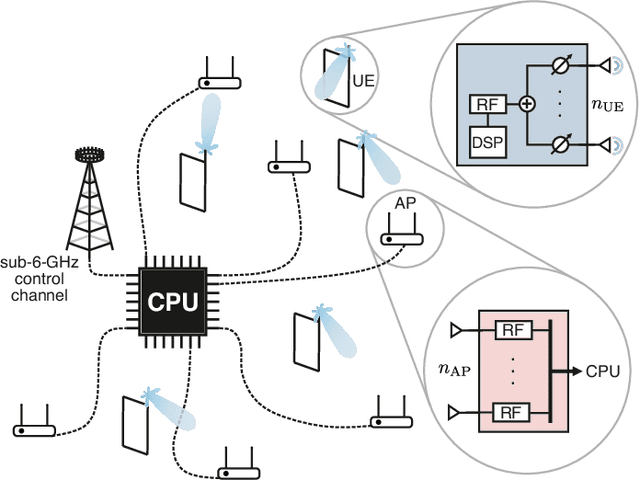
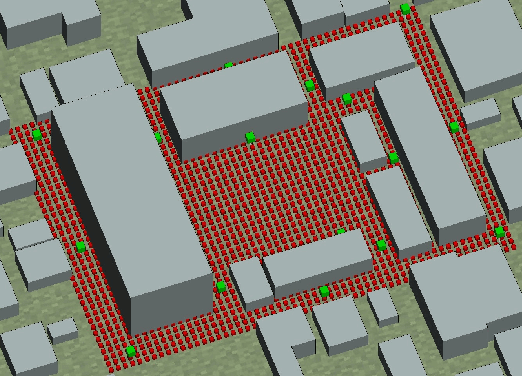


Abstract:Millimeter-wave (mmWave) cell-free massive multi-user (MU) multiple-input multiple-output (MIMO) systems combine the large bandwidths available at mmWave frequencies with the improved coverage of cell-free systems. However, to combat the high path loss at mmWave frequencies, user equipments (UEs) must form beams in meaningful directions, i.e., to a nearby access point (AP). At the same time, multiple UEs should avoid transmitting to the same AP to reduce MU interference. We propose an interference-aware method for beam alignment (BA) in the cell-free mmWave massive MU-MIMO uplink. In the considered scenario, the APs perform full digital receive beamforming while the UEs perform analog transmit beamforming. We evaluate our method using realistic mmWave channels from a commercial ray-tracer, showing the superiority of the proposed method over omnidirectional transmission as well as over methods that do not take MU interference into account.
An Optimization-Based User Scheduling Framework for mmWave Massive MU-MIMO Systems
Jun 23, 2022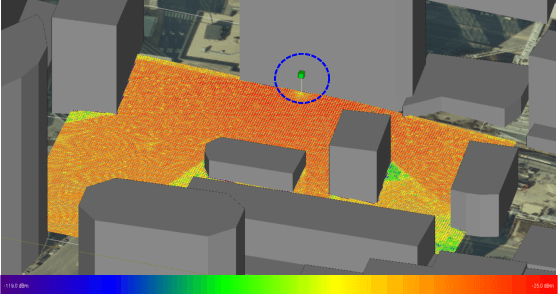
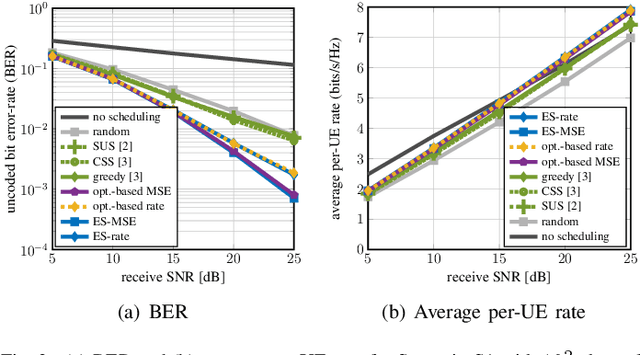
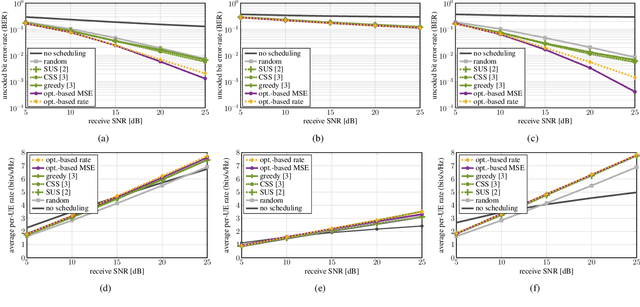

Abstract:We propose a novel user equipment (UE) scheduling framework for millimeter-wave (mmWave) massive multiuser (MU) multiple-input multiple-output (MIMO) wireless systems. Our framework determines (sub)sets of UEs that should transmit simultaneously in a given time slot by approximately solving a nonconvex optimization problem using forward-backward splitting. Our UE scheduling framework is flexible in the sense that it (i) supports a variety of cost functions, including post-equalization mean square error and sum rate, and (ii) enables precise control over the minimum and maximum number of resources the UEs should occupy. We demonstrate the efficacy of our framework using realistic mmWave channel vectors generated with a commercial ray-tracer. We show that our UE scheduler outperforms a range of existing scheduling methods and closely approaches the performance of an exhaustive search.
 Add to Chrome
Add to Chrome Add to Firefox
Add to Firefox Add to Edge
Add to Edge